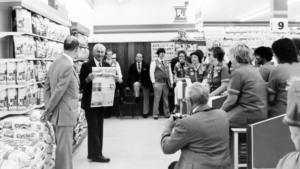Aaron Krause started out in 2004, by fixing printing equipment. A part of his job the pain was getting ink all over his hands. He could never find a tool that was strong enough to remove the ink. Amongst his pain there was an underlying product waiting to happen. Krause came up with the idea of a hand scrubber. This innovation helped him a lot, he later produced the idea and patented it. The problem came into place when retail stores started to complain about how expensive the hand scrubber was, and they didn’t see the value in the product. Later in 2013, he came across a dirty chair to wash it with a normal scrubber he scratched the paint. Krause then searched the house for a new tool and came across his old innovation. He tried his hand scrubber on the chair, and it worked perfectly. There were no scratches and when he was done using the sponge it looked perfectly the way it was. That’s when he knew he was targeting the wrong audience. After struggling to enter his product into bigger retail stores he decided to audition for Shark Tank. Sealing the deal with Lori Griener opened up powerful and large retail stores that would allow scrub daddy exposure to its correct target market. Till this day scrub daddy was the most successful product to date on Shark Tank. One connection on Shark Tank allowed scrub daddy to grow and maximize its potential as a scrubber.
Author Archive for Lily.Lagaras
The company Montblanc has a long history of creating pens with built-in ink well. This brand is commonly known for their luxury pens and accessories. Montblanc is over 100 years old; it originally came to be in Berlin when August Eberstein, Hamburg Banker and Alfred Nehemias created standard everyday pens. But when Wilhelm Digambar, Christian Lausen and Claus Johannes Voss bought the company in 1908 they changed the design to fountain pens and manufacture the pens with high-class gold. Their first product launch as a newly founded company was called Rouge et Noir. The name Montblanc came from the highest mountain in Europe. This was an important piece to their brand image. Naming their brand something everyone in Europe knew about and respected for its beauty. Their mission to serve Europeans with the highest quality pens and accessories, their detailed designs make this company stand out from their competitors. Their famous pen called Meisterstuck and 149 Montblanc fountain was launched and soon became a timeless and iconic luxury pen. Their advertising ideas pushed their brand image in a positive direction. The company moved at an even faster pace when they included a credible source of advertising. President Kennedy used the Meisterstuck 149, when people caught wind of that people could trust the business and proceeded to buy more! Montblanc has had great success in building a reliable, high quality (good designs) and luxury brand.
Despite Chick fil-A’s great success in the beginning of their business ventures the leaders of Chick fil-A experienced a difficulty in 1982. Once other chicken companies entered the competition Chick fil-A experienced lowering in sales and higher pricing in chicken. Once the leaders got ahold of how they wanted to differentiate themselves they sales a complete change in the company. The leaders created a “corporate purpose” which was “To glorify God by being a faithful steward of all that is entrusted to us. To have a positive influence on all who meet Chick-fil-A”. While this was instated customers saw the difference between people’s character at Chick-fil-A vs. other fast-food chains. The leaders of Chick-fil-A knew what was important to their customers so they wanted to emphasize this message to improve their brand image. Personally, when I think of Chick-fil-a I think about their consistent kind employees, fast service and great food. Chick-fil-a’s customer service is what allows customers to trust their experience Chick-fil-A. Relying on Chick-fil-a for a good experience is mostly why I choose to eat there. The founder of Chick-fil-A, Cathy Truett had an early experience with God and put his faith in God at a young age. This influenced the foundation of his business allowing his mission to focus on his connection with customers and employees rather than his profit. Treating his employees in a Christ lie manner created employee loyalty, which made customer interaction so much better. Another factor that increased employee loyalty was the college scholarships that are offered to employees who have worked there for over a year. Stewarding a brand in a Christ like character can benefit customer experience and expose how Chick-fil-A value is greater than any other fast-food restaurant you go to.
Todd Graves is man who pursued his niches in fried chicken and innovation. In the 1990’s Todd Graves was a young 20-year-old who wanted to create a restaurant that only serves fried chicken. In college he presented it to his professors, and they said it would not work. After college he tried to get loans, but banks would not give him any loans. Todd Graves was a determined and risky young man who was passionate about his idea, he did not want to give up on his idea. Todd was a horse working 20-hour days in the oil and fishing business. He was not giving up but saving for his dreams of owning a restaurant. Todd eventually moves home with money to start his business. In 1996 building started on the North Gates of Louisiana State University. Todd was very involved in the building work on the restaurant, his involvement with the day-to-day construction process helped him see the vision of his business. During the first renovation renovators chipped walls paint away and there was logo design that inspired the future raising canes brand design. Raising Canes has made a name for themselves of great brand techniques which have expressed their differentiation from other restaurant chains. They have made a name for themselves as a brand who serves the community well. Todd took an idea that no one believed in and made a name for himself in his perseverance and hard work. Todd’s niche for fried chicken has made him billions and has been the factor for fried chicken to unite communities.
Squatty potty started with a family who found themselves having bathroom problems. The owners of squatty potty are Bill, Judy and their son Bobby Edward, they live in Saint George, Utah. In 2010, Judy consulted a doctor who told her to squat to relax her colon. Judy wondered how she was going to squat and sit on the toilet at the same time. She started using a step stool to position her feet, but it wasn’t comfortable because the height of the stool was either too high or low. As soon as Bobby heard about his mother’s problem, he immediately started thinking of ways he could produce a stool that fits with the parameters of the toilet. Bobby designed and created a U-shaped stool in the family’s garage. This design became exactly what Judy needed, but it didn’t just stop there. They continued to make them and give them to families and friends for gifts. Edwards realized that they weren’t the only ones who had this problem. They started selling online in 2011, squatty potty gained a lot of traction and produced 1 million in sales in the first year! This opened doors for them to sell squatty potty all over the US and in 17 different countries. After airing on the Dr. Oz show the sales sextupled and Edwards had to seriously upscale their production to match demand. After selling a deal accepting 350,000 investments with the exchange of 10% stake in the company with Lori Griener, they gained 1 million in sales that night and then after the show aired, they gained 3 extras million in sales. The funny and efficient elements of the squatty potty brand is what gains so much attention to the product. This family took a personal problem (pain) that could be embarrassing but they embraced their problems and made it her passion.
Aaron Krause started out in 2004, by fixing printing equipment. A part of his job the pain was getting ink all over his hands. He could never find a tool that was strong enough to remove the ink. Amongst his pain there was an underlying product waiting to happen. Krause came up with the idea of a hand scrubber. This innovation helped him a lot, he later produced the idea and patented it. The problem came into place when retail stores started to complain about how expensive the hand scrubber was, and they didn’t see the value in the product. Later in 2013, he came across a dirty chair to wash it with a normal scrubber he scratched the paint. Krause then searched the house for a new tool and came across his old innovation. He tried his hand scrubber on the chair, and it worked perfectly. There were no scratches and when he was done using the sponge it looked perfectly the way it was. That’s when he knew he was targeting the wrong audience. After struggling to enter his product into bigger retail stores he decided to audition for Shark Tank. Sealing the deal with Lori Griener opened up powerful and large retail stores that would allow scrub daddy exposure to its correct target market. Till this day scrub daddy was the most successful product to date on Shark Tank. One connection on Shark Tank allowed scrub daddy to grow and maximize its potential as a scrubber.After Krause successes his story has made him eager to support young business who do not have the resources to get off the ground. Krause has an appreciation of the struggle he went through since it has payed off tremendously
Sam Walton, the founder of Walmart, started with a failed business idea in the 1960s. Sam Walton pitched his idea of a small-town discount store to his prior retail company’s council and was rejected. After being denied, Sam Walton was not discouraged and ventured on with his discount store idea. Sam Walton changed the face of retail by seeing the problem of lousy service and high prices. He filled the need and created Walmart to serve customers with good customer service and low prices. In the early 1970s, Sam Walton placed 30 Walmarts in places where there wasn’t a lot of competition. Walton solved another problem by targeting rural areas. Rural places appreciated how close and local Walmart was compared to places in the urban areas. “I had no vision of the scope of what I would start. But I had confidence that as long as we did our work well and were good to our customers, there would be no limit to us.” – Sam Walton. Walmart’s priority is its customers, and what plays a big part in this is listening to the employees who speak with them directly from day to day. This communication within the business is how they can target their markets so well and deliver value regularly. Sam Walton instilled low cost, which benefited Walmart with high sales rates, significant margins, and high revenues. Low cost has been sustainable for Walmart since they offer so many varieties of products. Customers can make a one-stop trip to meet all their needs and wants. Sam’s famous techniques were ultimately guided by making the product cheaper, providing customer service, and locating the stores where the competition wasn’t.
Copyright © 2025 All Rights Reserved
 bobby
bobby 